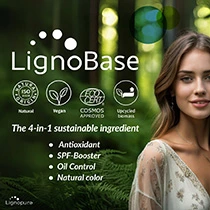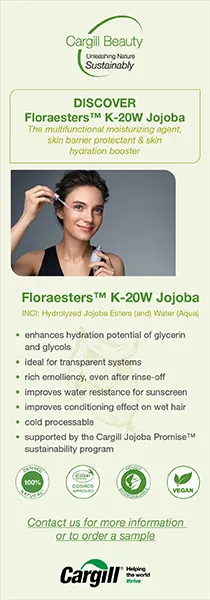PhytoGaia on how its beauty-from-within solution tackles cellular skin aging

PhytoGaia has received approval for a human clinical trial to evaluate STGaia’s role in healthy aging, cellular longevity, and telomere preservation. The complex contains a mixture of tocotrienols and plant squalene. The company claims that STGaia is “the first” in the market to offer this combination.
The trial, which will last six months, is held in collaboration with Monash University, Malaysia, and will include participants aged 50–57.
The primary objective is to investigate biomarkers of biological aging — such as telomere length and telomerase activity — cellular longevity, antioxidant enzyme activity, and inflammation markers.
Personal Care Insights speaks with Dr. Ariati Aris, scientific affairs specialist at PhytoGaia, about how the complex interacts with human cells on a biological level and aims to battle the inevitable hallmarks of aging.
“Consumers are looking for ways to stay youthful, energetic, and healthy as they age, not just on the outside, but from the inside out. This growing focus on healthy aging and longevity has created demand for products beyond surface beauty, supporting skin and cellular health at a deeper level,” says Aris.
STGaia is touted to offer a science-backed, beauty-from-within solution that works at the cellular level to protect and rejuvenate skin, complementing daily skin care routine from the inside.
Aris adds that it helps defend skin against the stressors of modern life, such as UV exposure and pollution, while supporting long-term skin vitality. It is also an antioxidant and hydrating.
“The overall objective of this study is to investigate the impact of STGaia supplementation on antioxidant and aging processes, particularly focusing on telomere dynamics,” he says.
Cosmeceutical applications
Squalene is popular in skin care due to its powerful antioxidant and moisturizing properties.
 Tocotrienols and squalene synergistically support cellular longevity. As we age, the squalene amount in the sebum reduces gradually, leading to dryness and loss of elasticity. “By replenishing squalene and boosting it with tocotrienols, it helps restore youthful hydration, protection, and glow — whether taken internally or applied topically,” says Aris.
Tocotrienols and squalene synergistically support cellular longevity. As we age, the squalene amount in the sebum reduces gradually, leading to dryness and loss of elasticity. “By replenishing squalene and boosting it with tocotrienols, it helps restore youthful hydration, protection, and glow — whether taken internally or applied topically,” says Aris.
“[STGaia ] is a palm phytonutrient complex consisting of natural squalene and full-spectrum tocotrienol (alpha-, beta-, gamma-, and delta-tocotrienol) complex, touted as ‘super vitamin E’,” says Aris.
“Squalene and tocotrienols are used widely and individually in topical and oral cosmetics. However, it’s not in a combination yet, making it the first-of-its-kind.”
Hallmarks of aging
Telomere shortening is recognized as a hallmark of aging, and strategies to maintain telomere integrity are gaining attention in longevity research.
“Telomeres are repetitive nucleotide sequences that form a protective cap at the ends of chromosomes, preserving their integrity and stability. Telomere shortening occurs at each DNA replication, and if continued, leads to chromosomal degradation and cell death,” explains Aris.
Oxidative stress accelerates telomere shortening, triggering premature cellular aging.
“Tocotrienols have shown promising effects in supporting telomere health. Emerging research suggests that tocotrienols help preserve telomere integrity by mitigating oxidative damage and enhancing DNA repair mechanisms,” says Aris.
Working in synergy
Tocotrienols and squalene synergistically support cellular longevity by protecting and nourishing cells at multiple levels.
Aris explains that tocotrienol helps neutralize free radicals — unstable molecules that can damage cellular structures — including DNA, proteins, and membranes.
“Research has shown that tocotrienols can support healthy mitochondrial function and reduce chronic inflammation, two key factors linked to cellular aging and age-related diseases.”
Meanwhile, squalene complements tocotrienols by maintaining cellular hydration, protecting cells from oxidative damage, and supporting membrane fluidity.  Tocotrienols may also improve skin tone by reducing oxidative triggers of hyperpigmentation.
Tocotrienols may also improve skin tone by reducing oxidative triggers of hyperpigmentation.
“Squalene plays a protective role, especially in skin cells, by enhancing the skin barrier function and helping to counter environmental stressors. Additionally, it serves as a precursor for synthesizing important biomolecules like sterols and hormones, which are essential for cellular repair and regeneration.”
This helps create a more stable internal environment for preserving telomeres. He argues that these compounds create a powerful defence system that shields cells from damage and helps sustain their optimal function over time.
“In summary, by reducing oxidative stress and supporting cellular repair mechanisms, both tocotrienols and squalene may help slow telomere attrition, promoting healthier, longer-living cells.”
Skin repair from within
Tocotrienols and squalene are increasingly recognized as nutricosmetic ingredients, aligning with the growing demand for beauty-from-within and longevity-focused skin care.
Aris adds that the synergy supports the skin’s lipid barrier. Its emollient properties also help reduce trans-epidermal water loss, promoting long-lasting skin comfort. It also works as an anti-aging agent from within, slowing down collagen breakdown.
“Its strong antioxidant and anti-inflammatory properties protect skin structures (collagen and elastin), helping maintain firmness and smoothness,” says Aris.
Their defense against UV-induced oxidative damage “may help reduce photoaging and support skin recovery after sun exposure.”
Tocotrienols may also improve skin tone by reducing oxidative triggers of hyperpigmentation, leading to brighter, more even skin.
“Tocotrienols and squalene are ideal for nutricosmetic formulations aimed at supporting youthful skin, cellular health, and overall beauty longevity from within, making them powerful allies in the pursuit of graceful, healthy aging,” Aris concludes.












